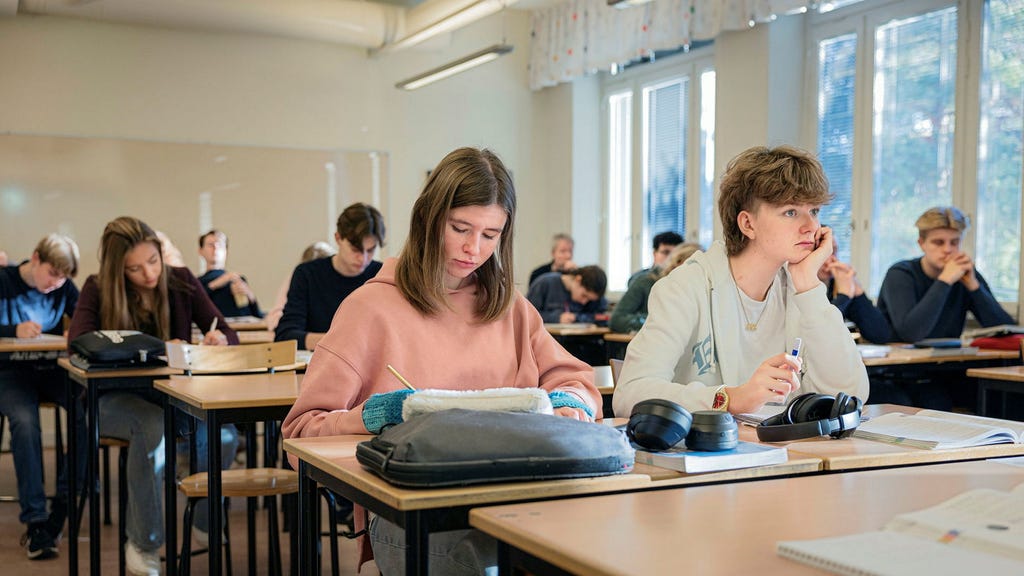The first day back after a break at Blackebergs gymnasium finds the first-year natural science students enjoying a well-deserved sleep-in. Their arrival in the classroom is marked by a cheerful relinquishing of their mobile phones into a designated box, a practice implemented to enhance their learning environment. This seemingly simple act, along with the benefit of extra sleep, contributes significantly to reducing cognitive load, a key concept in educational science. By minimizing distractions, the students’ mental capacity is freed up to focus on more demanding tasks, optimizing their learning potential. This is the philosophy of their math teacher, Jesper Nelsén, who emphasizes the importance of creating an optimal learning environment for his students.
Jesper Nelsén is currently enrolled in a newly established course, ”Teaching on a Cognitive Science Basis.” This reflects a growing trend in education, where cognitive psychology and experimental neuroscience converge to create a research field focused on evidence-based classroom practices. The course, offered at only four institutions with limited capacity, is in high demand, indicative of the burgeoning interest in this approach to teaching. This surge in interest is fueled by the growing body of research in this field, which is now substantial enough to raise awareness and drive the demand for evidence-based teaching strategies. The government, recognizing the importance of this shift, has initiated several investigations to promote the integration of scientific evidence into educational practices. The National Audit Office has also launched an inquiry into school authorities’ adherence to scientifically grounded advice for teachers.
The importance of evidence-based teaching practices is exemplified by the ongoing ”reading war” in Swedish educational circles, a debate focusing on effective reading instruction methods. The discussion centers around the inadequacy of teacher training programs, particularly in equipping new teachers with the phonics method, a proven approach to teaching reading. This deficiency is reflected in international studies, such as Pirls, which reveal concerning literacy rates among young students. This struggle for effective teaching extends beyond Sweden, constituting a global movement known as ”Science of Learning,” with the popular American podcast ”Sold a Story: How Teaching Kids to Read Went So Wrong” bringing the issue to the forefront of public discourse. The podcast highlights the prevalence of ineffective reading instruction methods and their detrimental impact on children’s literacy development.
Back in the classroom, Jesper Nelsén employs traditional teaching methods, illustrating mathematical functions on the blackboard. His students, Julia Stjerna and Melker Sandin, appreciate the value of repetition for solidifying learning and transferring knowledge to long-term memory. This aligns with the cognitive science principle of memory retrieval, an active process that surpasses passive rereading or re-listening to lectures. Jonas Linderoth, professor of pedagogy, advocates for ”desirable difficulties,” comparing passive learning to consuming a pastry – enjoyable in the moment but lacking lasting nutritional value. He encourages active recall, advising students to test their knowledge without relying on their books. Similarly, rote memorization of fundamental concepts, like multiplication tables or irregular verbs, frees up working memory for more complex tasks, a principle that has been somewhat overlooked in recent curriculum revisions that prioritized analytical skills over basic knowledge.
While Julia and Melker appreciate Jesper’s teaching style, particularly his use of humor and anecdotes, Jesper himself grapples with the cognitive science mantra of ”teach the stuff and cut the fluff.” He questions whether his attempts to lighten the mood might actually hinder his students’ concentration, particularly during challenging lessons. This internal debate reflects the tension between creating an engaging learning environment and adhering to principles of minimizing distractions. This also touches upon a prevalent misconception that learning should be primarily driven by fun and enjoyment, a notion underlying the ineffective reading instruction methods criticized in the ”Sold a Story” podcast. Current research emphasizes that motivation stems from achievement, meaning that a teacher’s primary focus should be on facilitating understanding and success, thereby fostering motivation. This approach to teaching empowers students and cultivates a positive learning experience.
The students’ perspective on learning is also insightful. They believe that everyone learns differently and advocate for personalized learning methods. Melker, for example, finds that listening to music aids his concentration while solving math problems, while Julia uses her phone for self-testing during homework. While these methods might work for them, research suggests that students are not always aware of the most effective learning strategies. The example of ”ear reading” or listening to texts as a substitute for reading highlights this point. While helpful for students with documented learning disabilities, its widespread use as a replacement for actual reading indicates a concerning trend. This reliance on accommodations, while seemingly beneficial in the short term, can hinder students’ ability to engage with standard assessment formats, as evidenced by the increasing number of students unable to complete standardized tests. This underscores the importance of adopting evidence-based teaching methods and moving away from practices that may hinder genuine learning. The hope is that the current focus on cognitive science in education will lead to a sustained shift towards more effective teaching practices, benefiting both teachers and students.














